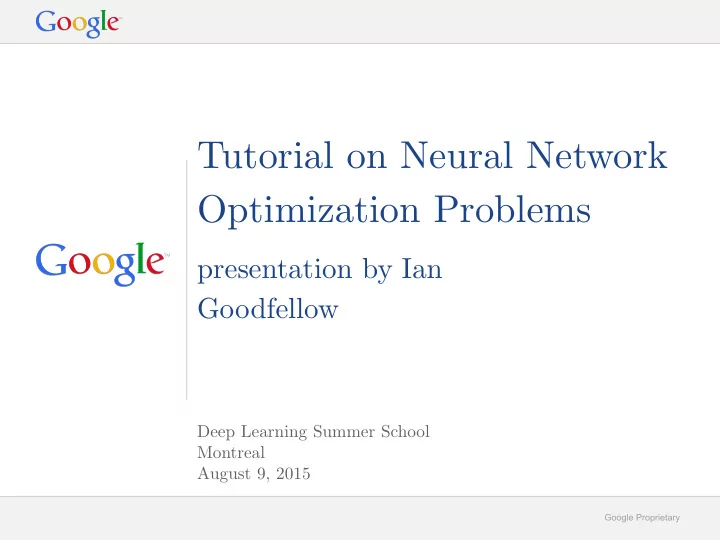

Tutorial on Neural Network Optimization Problems presentation by Ian Goodfellow Deep Learning Summer School Montreal August 9, 2015 Google Proprietary
Optimization -Exhaustive search -Random search (genetic algorithms) -Analytical solution -Model-based search (e.g. Bayesian optimization) -Neural nets usually use gradient-based search Google Proprietary
In this presentation…. - “Exact Solutions to the Nonlinear Dynamics of Learning in Deep Linear Neural Networks.” Saxe et al, ICLR 2014 - “Identifying and attacking the saddle point problem in high-dimensional non-convex optimization.” Dauphin et al, NIPS 2014 - “The Loss Surfaces of Multilayer Networks.” Choromanska et al, AISTATS 2015 - “Qualitatively characterizing neural network optimization problems.” Goodfellow et al, ICLR 2015 Google Proprietary
Derivatives and Second Derivatives Google Proprietary
Directional Curvature Google Proprietary
Taylor series approximation Baseline Linear Correction change from due to directional gradient curvature Google Proprietary
How much does a gradient step improve? Google Proprietary
Critical points Zero gradient, and Hessian with… All positive eigenvalues All negative eigenvalues Some positive and some negative Google Proprietary
Newton’s method Google Proprietary
Newton’s method’s failure mode Google Proprietary
The old myth of SGD convergence - SGD usually moves downhill - SGD eventually encounters a critical point - Usually this is a minimum - However, it is a local minimum - J has a high value at this critical point - Some global minimum is the real target, and has a much lower value of J Google Proprietary
The new myth of SGD convergence - SGD usually moves downhill - SGD eventually encounters a critical point - Usually this is a saddle point - SGD is stuck, and the main reason it is stuck is that it fails to exploit negative curvature Google Proprietary
Some functions lack critical points Google Proprietary
SGD may not encounter critical points Google Proprietary
Gradient descent flees saddle points (Goodfellow 2015) Google Proprietary
Poor conditioning Google Proprietary
Poor conditioning Google Proprietary
Why convergence may not happen - Never stop if function doesn’t have a local minimum - Get “stuck,” possibly still moving but not improving - Too bad of conditioning - Too much gradient noise - Overfitting - Other? - Usually we get “stuck” before finding a critical point - Only Newton’s method and related techniques are attracted to saddle points Google Proprietary
Are saddle points or local minima more common? - Imagine for each eigenvalue, you flip a coin - If heads, the eigenvalue is positive, if tails, negative - Need to get all heads to have a minimum - Higher dimensions -> exponentially less likely to get all heads - Random matrix theory: - The coin is weighted; the lower J is, the more likely to be heads - So most local minima have low J! - Most critical points with high J are saddle points! Google Proprietary
Do neural nets have saddle points? - Saxe et al, 2013: - neural nets without non- linearities have many saddle points - all the minima are global - all the minima form a connected manifold Google Proprietary
Do neural nets have saddle points? - Dauphin et al 2014: Experiments show neural nets do have as many saddle points as random matrix theory predicts - Choromanska et al 2015: Theoretical argument for why this should happen - Major implication: most minima are good, and this is more true for big models. - Minor implication: the reason that Newton’s method works poorly for neural nets is its attraction to the ubiquitous saddle points. Google Proprietary
The state of modern optimization - We can optimize most classifiers, autoencoders, or recurrent nets if they are based on linear layers - Especially true of LSTM, ReLU, maxout - It may be much slower than we want - Even depth does not prevent success, Sussillo 14 reached 1,000 layers - We may not be able to optimize more exotic models - Optimization benchmarks are usually not done on the exotic models Google Proprietary
Why is optimization so slow? We can fail to compute good local updates (get “stuck”). Or local information can disagree with global information, even when there are not any non-global minima, even when there are not any minima of any kind Google Proprietary
Linear view of the difficulty Google Proprietary
Factored linear loss function Google Proprietary
Attractive saddle points and plateaus Google Proprietary
Questions for visualization - Does SGD get stuck in local minima? - Does SGD get stuck on saddle points? - Does SGD waste time navigating around global obstacles despite properly exploiting local information? - Does SGD wind between multiple local bumpy obstacles? - Does SGD thread a twisting canyon? Google Proprietary
History written by the winners - Visualize trajectories of (near) SOTA results - Selection bias: looking at success - Failure is interesting, but hard to attribute to optimization - Careful with interpretation: SGD never encounters X, or SGD fails if it encounters X? Google Proprietary
2D Subspace Visualization Google Proprietary
A Special 1-D Subspace Google Proprietary
Maxout / MNIST experiment Google Proprietary
Other activation functions Google Proprietary
Convolutional network The “wrong side of the mountain” effect Google Proprietary
Sequence model (LSTM) Google Proprietary
Generative model (MP-DBM) Google Proprietary
3-D Visualization Google Proprietary
3-D Visualization of MP-DBM Google Proprietary
Random walk control experiment Google Proprietary
3-D plots without obstacles Google Proprietary
3-D plot of adversarial maxout Google Proprietary
Lessons from visualizations •For most problems, there exists a linear subspace of monotonically decreasing values • For some problems, there are obstacles between this subspace the SGD path • Factored linear models capture many qualitative aspects of deep network training Google Proprietary
Conclusion Do not blame optimization troubles on one specific boogeyman simply because it is the one that frightens you. Consider all possible obstacles, and seek evidence for which ones are there. Local minima -> gradient norm Conditioning -> uphill steps + changing gHg Noise -> uphill steps + varying g Saddle points -> gradient norm + negative eigenvalue etc. Make visualizations! Consider yourself challenged to show us the obstacle . Google Proprietary
Recommend
More recommend